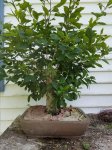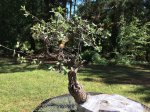SU2
Omono
While I'd been mostly collecting bougies, which can be done with success in our winter (FL gulf coast zone 9a/9b line), I'm starting to get a wider variety of stuff and am hoping to learn when the best time is for:
- heavy pruning of an established, healthy plant,
- 'hard-chopping' a large/tall specimen to a small pre-bonsai, and
- collecting/transplanting yamadori (w/ and w/o foliage- am unsure if it makes a difference whether they're just stumps or if they're sporting a couple branches w/ leaves)
Am also interested in whether anyone's found some FL yamadori that require "two-stepping" ie doing the hard-chop, and the transplant/collection, at two separate times (for instance, I've tried to collect countless oaks, both Live Oak and Laurel Oak, and never once got one to survive, to the point I was almost convinced they couldn't be transplanted! Right now I've got 'experiment' oaks, naturally-growing on my property, that I've hard-chopped and left in-ground, in ~a month I'm going to saw a circle around them in the ground to sever roots & encourage the roots to branch, then at a later time actually dig it out - hopefully getting my first successful Oak tree!!)
The main species that I'm aiming for right now are hawthorns privets and a couple others, want to build my non-tropical collection up!! Thanks for any info/advice/thoughts on this subject, I get almost all my material from the wild (or 'yardadori') and am barely at a year in this hobby, want to be sure I'm on-point with everything when summer starts winding-down into autumn
- heavy pruning of an established, healthy plant,
- 'hard-chopping' a large/tall specimen to a small pre-bonsai, and
- collecting/transplanting yamadori (w/ and w/o foliage- am unsure if it makes a difference whether they're just stumps or if they're sporting a couple branches w/ leaves)
Am also interested in whether anyone's found some FL yamadori that require "two-stepping" ie doing the hard-chop, and the transplant/collection, at two separate times (for instance, I've tried to collect countless oaks, both Live Oak and Laurel Oak, and never once got one to survive, to the point I was almost convinced they couldn't be transplanted! Right now I've got 'experiment' oaks, naturally-growing on my property, that I've hard-chopped and left in-ground, in ~a month I'm going to saw a circle around them in the ground to sever roots & encourage the roots to branch, then at a later time actually dig it out - hopefully getting my first successful Oak tree!!)
The main species that I'm aiming for right now are hawthorns privets and a couple others, want to build my non-tropical collection up!! Thanks for any info/advice/thoughts on this subject, I get almost all my material from the wild (or 'yardadori') and am barely at a year in this hobby, want to be sure I'm on-point with everything when summer starts winding-down into autumn
Last edited:





